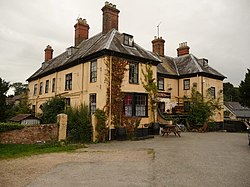Everleigh
| Everleigh | |
| Wiltshire | |
|---|---|
 The Crown Hotel | |
| Location | |
| Grid reference: | SU204538 |
| Location: | 51°16’59"N, 1°42’29"W |
| Data | |
| Population: | 211 (2011) |
| Post town: | Marlborough |
| Postcode: | SN8 |
| Dialling code: | 01264 |
| Local Government | |
| Council: | Wiltshire |
| Parliamentary constituency: |
Devizes |
| Website: | http://www.everleigh.org/ |
Everleigh, pronounced and also sometimes spelt Everley, is a village in the east of Wiltshire, about four and a half miles south-east of the town of Pewsey, towards the northeast of Salisbury Plain.
The village is also known as East Everleigh, to distinguish it from the hamlet of Lower Everleigh which stands about a mile further west on the A342 road that connects Andover and Devizes. The village is surrounded by land known as Everleigh Drop Zone, owned by the Ministry of Defence that is used for military training as part of the Salisbury Plain Training Area.
History
The partly-forested area was known for recreational hunting. By the 13th century there was a deer park and a rabbit warren, and later activities included hare coursing, falconry and racehorse training. East Everleigh developed at a crossroads where the old Marlborough-Salisbury road (now only a track in the south of the parish) met the Devizes-Andover road (now the A342). In the 18th and 19th centuries, several inns provided refreshment and lodging.[1]
The Everleigh estate was bought by Sir John Astley in 1765, and inherited in 1771 by his cousin Francis Dugdale Astley; it continued as the seat of the Astley baronets until the middle of the next century. Sir Francis made changes to the village layout around 1811, removing buildings which stood close to the manor house and diverting the road away from it. Those demolished included the old church (rebuilt by Sir Francis further west) and the Rose and Crown inn.[1]
Manor house
James VI and I and Anne of Denmark came from Wilton House to Everleigh on 31 August 1603 to visit Mr Sadler, a son of Queen Elizabeth's falconer Ralph Sadler.[2]
The present Everleigh Manor was built in the 18th century, possibly on the site of the earlier house, and extended with east and west wings later in the century. In 1882 the central block was virtually reconstructed following a fire. It is a two-storey country house in brick and stone, originally five bays, extended to nine.[1][3]
The Manor House was once a holding area for the prisoners during the Bloody Assizes with trials held by Judge Jeffreys in 1685. It was connected to a public house nearby, known as "The Crown", by a tunnel where prisoners would be led to and from the court house and manor. The tunnel is now blocked up on either end of both the manor and public house, but the tunnel still exists to this day.[4]
The manor house was bought by the National Deposit Friendly Society in 1921, for use as a convalescent home. The house was requisitioned in 1939 and, with new buildings added in its grounds, became a military hospital used by the US Army; there was also a vaccine laboratory. In 1951 the west wing was named the David Bruce Laboratory, and by this time the site was used by the Royal Army Medical Corps; the house and grounds were bought by the War Office in 1954. The Ordnance Survey 1:25,000 map of 1958 shows many small buildings in the grounds to the north-west of the manor house.[5][1]
The Army left the site c. 1990[6][7] and the house returned to use as a private residence.[3] As of 2016, the west wing is operated as a hotel.[8]
Parish church
Everleigh had a parish church by 1228, when it was granted to the Benedictine Wherwell Abbey in Hampshire.[1] However, the mediæval parish church was demolished in 1814 when the present Church of England parish church of St Peter was consecrated on a site about half a mile north-west of it.[1]
The present church was designed by the architect John Morlidge[1] in a Georgian Gothic Revival style.[9] It includes the original Norman font from the old church.[9]
The Wiltshire and Swindon History Centre holds the parish registers for 1598 to 1971 (baptisms), 1598-1974 (marriages), and 1598-1984 (burials). The population in 1831 was 352, but by 1951 it had fallen to 264.[10]
Rev. Prof. John Wallis (1675-1738), who was rector of Everleigh from 1716, was at the same time Laudian Professor of Arabic at the University of Oxford.[1] In the 1760s the living was held by John Butler, who was later Bishop of Oxford and Bishop of Hereford.
Leisure
The Orange Way long-distance footpath passes through Everleigh village in a southwest–northeast direction.[11]
Outside links
| ("Wikimedia Commons" has material about Everleigh) |
References
- ↑ 1.0 1.1 1.2 1.3 1.4 1.5 1.6 1.7 A History of the County of Wiltshire - Volume 11 pp 135-142: Parishes: Everleigh (Victoria County History)
- ↑ John Nichols, Progresses of James the First, vol. 1 (London, 1828), p. 255.
- ↑ 3.0 3.1 National Heritage List 1181039: Everleigh Manor (Grade II listing)
- ↑ "Totally Haunted". October 2009. http://totallyhaunted.co.uk/the-crown-hotel.php. Retrieved 21 October 2018.
- ↑ "Ordnance Survey 1:25,000 maps of Great Britain, sheet SU25". http://maps.nls.uk/view/95749875. Retrieved 1 September 2016.
- ↑ "Everleigh Village Design Statement". August 2006. http://www.wiltshire.gov.uk/everleigh_village_design_statement.pdf. Retrieved 1 September 2016.
- ↑ National Heritage List 1364559: West wing, David Bruce House
- ↑ "The West Wing". http://thewestwing.biz/. Retrieved 1 September 2016.
- ↑ 9.0 9.1 Pevsner & Cherry, 1975, page 242
- ↑ Information on Everleigh from GENUKI
- ↑ "Orange Way". Long Distance Walkers Association. https://www.ldwa.org.uk/ldp/members/show_path.php?path_name=Orange+Way. Retrieved 10 September 2016.